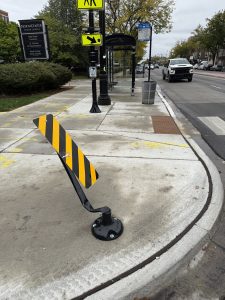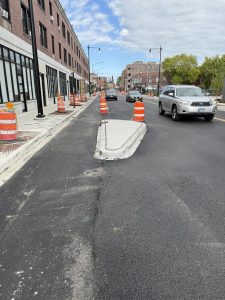By Zneimer & Zneimer, P.C.
As Chicago works to implement Vision Zero, the legal landscape of traffic collisions is shifting—and so must how drivers operate, how plaintiffs’ lawyers approach cases, and how the public understands responsibility.
What Is Vision Zero?
Vision Zero is a traffic-safety philosophy that treats traffic deaths and severe injuries as unacceptable rather than inevitable. The core principle: we can design systems that absorb human error so mistakes don’t become tragedies. The personal injury lawyers of Zneimer & Zneimer, P.C. support the Vision Zero philosophy even though the improvements have lead to some driver inconveniences.
In Chicago, Vision Zero officially began with the 2017 Vision Zero Action Plan, which set an ambitious target: eliminate traffic fatalities and serious injuries by 2026. (visionzerochicago.org) That plan builds on data showing where crashes are most frequent and dangerous, and directs safety investments accordingly.
How Chicago Is Trying to Make Streets Safer
Here are some of the key street design and policy strategies Chicago is rolling out under Vision Zero:
Bump-Outs / Curb Extensions
Often called bump-outs, curb extensions, or bulb-outs, these are extensions of the sidewalk into the roadway (sometimes via paint, flexible posts, or permanent concrete). The goals are:
- Shorten the crossing distance for pedestrians
- Improve visibility between people walking and drivers (so pedestrians are less obscured by parked cars)
- Slow turning vehicles by reducing turning radii
For example, along Lincoln Ave. and along Western Ave. the city has installed paint-and-post sidewalk extensions and permanent concrete bump-outs at intersections to encourage slower speeds and safer crossings.
Marked Crosswalks, Raised Crosswalks & Pedestrian Islands
To boost pedestrian visibility and protection, Chicago is installing more conspicuous crosswalks, raised crossings, and refuge islands—places where a pedestrian can pause safely mid-crossing. (City of Chicago) In corridors where bike lanes and pedestrian improvements have gone in (e.g. Jackson Boulevard), the city has seen reductions in speeding and crashes.
Traffic Calming & Left-Turn Modifications
Left-turning vehicles are particularly risky to pedestrians. To mitigate this, Chicago has introduced left-turn traffic calming treatment: centerline rubber bumps, bollards, raised median islands, and constraints to force slower, tighter, 90° turns. (Chicago Sun-Times) In 2019, a pilot in River North applied these modifications at five intersections; after implementation, crashes dropped by ~24 percent at those sites. Also, the proportion of drivers yielding to pedestrians at those intersections rose from ~73 percent to ~94 percent. s of recent years, Chicago has retrofitted 18 busy intersections with rubber speed bumps and bollards to slow left turns. (Chicago Sun-Times)
Speed Management, Narrow Lanes, Protected Bike Lanes
Other complementary strategies include:
- Narrower vehicle lanes to discourage speeding
- Protected bike lanes and buffer zones that effectively narrow the vehicle space and discourage fast driving or passing on shoulders
- Automated enforcement (e.g. red-light cameras, speed cameras) and signal timing adjustments
How Drivers Must Adjust (Especially to Bump-Outs & Calming Features)
These changes in street design are not without controversy. It is easy to see that drivers are not expecting these calming features in the roadway. Many warning signs are being run over and the cement features are black with rubber tire marks. Clearly drivers must
- Watch for roadway geometry changes
Bump-outs, curb extensions, and expanded pedestrian islands intrude into zones that once felt like “dead space” or shoulders. Drivers must leave more space, especially when turning, and not cut across these features. Over time, failing to anticipate bump-outs may lead to collisions with them or endanger pedestrians standing nearby.
- Slow down near intersections and crosswalks
Because crossing distances are shorter and pedestrians more visible, a pedestrian may step into the path of a vehicle where the driver may not expect them. Slower speeds give drivers more reaction time and reduce crash severity.
- Execute safer left turns
With left-turn traffic calming, drivers must take tighter, more controlled turns. Trying to turn aggressively or wide may lead to crossing into crosswalks, hitting bollards, or colliding with curb extensions.
- Yield to pedestrians more reliably
In upgraded intersections, drivers are being asked (and legally expected) to yield more consistently. In some modified intersections, the rate of yielding rose significantly after improvements.
- Be alert to new or temporary features
Some bump-outs are temporary “rapid-delivery” paint-and-post installations. Their visibility, especially in low light or bad weather, may be limited. Drivers must be alert for poles, signs, or deviations in pavement. In Jefferson Park, for example, residents expressed concern that new bump-out designs could pose hazards to vehicles if not clearly signed. (CBS News) On Western Ave. and Lincoln Ave. it is apparent that drivers have not adjusted to the new bump-out features and roundabouts judging from the skid marks on these features and the run over signage.
Have Chicago’s Efforts Worked?
The early data shows promise — though with caveats. Chicago has seen several positive outcomes in targeted corridors, though citywide reductions in fatalities and serious injuries are still a work in progress.
Remaining Challenges
- Despite targeted successes, Chicago still faces high numbers of serious injuries and deaths, especially among pedestrians and cyclists. (Safer America)
- Public backlash or confusion has arisen in places where new infrastructure feels intrusive or poorly signed
- Many small businesses complain that protected bike lanes take away scare parking spaces and hurt business. Additionally, these small business owners point out that these bike lanes are sparsely used during the summer and these bike lanes are not used at all during Chicago’s long winter months.
The personal injury lawyers of Zneimer & Zneimer P.C. know how devastating injuries from being hit by a car as a pedestrian and applaud any pedestrian safety improvements.
 Chicago Accident Lawyer Blog
Chicago Accident Lawyer Blog



